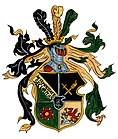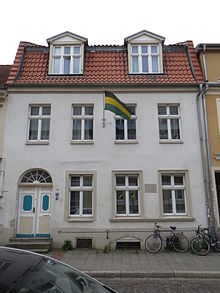KDStV Alemannia Greifswald and Münster
|
KDStV Alemannia |
||||||
|---|---|---|---|---|---|---|
| coat of arms | Circle | |||||

|

|
|||||
| Basic data | ||||||
| University location: | Greifswald Munster |
|||||
| University / s: |
University of Greifswald Westphalian Wilhelms University |
|||||
| Founding: | November 29, 1891 | |||||
| Place of foundation: | Greifswald | |||||
| Corporation association : | CV | |||||
| Association number: | 17th | |||||
| Abbreviation: | Ale! | |||||
| Color status : | colored | |||||
| Colours: |
|
|||||
| Fox colors: |
|
|||||
| Cap: | yellow occipital color | |||||
| Type of Confederation: | Men's association | |||||
| Religion / Denomination: | Catholic | |||||
| Position to the scale : | not striking | |||||
| Motto: | In tempestate securitas! | |||||
| Website: |
http://www.alemannia-greifswald.de http://www.alemannia-muenster.de |
|||||
The Catholic German Student Association Alemannia (KDStV Alemannia) to Greifswald and Münster in the Cartell Association of Catholic German Student Associations (CV) is a color-bearing, non-striking, Catholic, German student association founded in 1891. It exists simultaneously in Münster and Greifswald.
She is a member of the Rudelsburger Allianz , an association of all those student associations that developed a life of association in the GDR before the fall of the Berlin Wall.
history
The Catholic German student association Alemannia zu Greifswald and Münster in the CV was founded on November 29, 1891 initially as the "Free Association of Catholic Students Alemannia zu Greifswald" at the University of Greifswald . The seven founders of the student association decided on the name "Alemannia" with "regard to its patriotic meaning". According to the principles of the Cartell Association of Catholic German Student Associations (CV), of which the Greifswalder Alemannia had become a full member in mid-1892, its members committed themselves to the principles of "Faith", "Science" and "Friendship", and until around 1900 also that The principle of "love of the country" was added. In 1907 this principle found its way into the statutes of the CV at a suburb provided by Alemanni at the Cartel meeting.
At the beginning of the First World War there was also a certain euphoria among the Alemanni, but the active social life in Greifswald almost completely paralyzed in the years 1914–1918. After the end of the war, the remaining Alemanni joined the "appeal of the Innsbruck student body" of November 26, 1918, which called for the Greater German solution , and continued to celebrate the founding day of the Reich together with other Greifswald corporations as a commemoration; However, the attitude of the Alemanni was - probably due to their Catholic origin - overall friendly to the Republic.
In addition to the traditional Kommersen, games, singing and lecture evenings, the Alemanni followed various sporting activities such as fencing, horse riding, hiking, gymnastics and swimming, some of which they practiced with local colored gymnastics clubs. Sailing on the connection's own boat was extremely popular among the Alemanni. The "Alemanni sheets", which have been published since 1925, also served to strengthen the feeling of togetherness among the members.
However, the number of members of the Alemannia sank drastically until the mid-1920s, but from this time onwards they experienced an unexpected boom thanks to the efforts of the CV and the old men of the Alemannia, so that the association in Greifswald advanced to one of the strongest corporations. This increased presence was also expressed in increasing commitment to Greifswald University: Around 1930, Alemanni took up posts in the general student committee, which tried to assert itself against the growing NSDStB .
After the National Socialists came to power, attempts were initially made to meet the demands of the NSDStB - such as the establishment of comradeship houses. After the CV had taken a clear position in favor of National Socialism in 1934, the association disbanded in autumn 1935; Alemannia finally gave in to the pressure to unify the NSDStB in spring 1936 by dissolving itself. In July 1947 the Greifswald connection revived at a new place of activity in Münster.
Without knowing about the existence of the Alemannia in Münster, students from the Catholic Student Community (KSG) met in Greifswald in 1983 to revive the tradition of the Alemannia with the help of the chaplain and student chaplain Rainer Lau.
Fortunately, the piano and an old cupboard from the Alemannia (both with coat of arms), which contained the Kommers books, several other student song books and the years 3 to 22 of the association magazine Academia , had survived in the rooms of the student community. So the students found out about the earlier existence of the Alemannia and decided to re-establish it, not knowing that such a re-establishment had already taken place in 1947 in Münster, Westphalia. The fraternity consisted almost exclusively of bars at first. From 1986 there were recorded conventions; in the spring of 1987 a statute was adopted.
The Alemannia is the only known successful reactivation during the time of the GDR , at the same time the Alemannia reactivated twice separately. The GDR re-establishment took place in the belief that there was no longer any Alemannia in the West, at the same time the Neo-Alemanni in Greifswald had no idea that there had once been umbrella associations and a cartel association, how everyday life originally looked in a CV association would have.
When Helmut Josef Patt , a good friend of the Philistine senior at the time, happened to visit the GDR, he met a Catholic choral society in Greifswald that wore the Alemannia circle on its lapel as a kind of paint pin. Back at home he reported his observation, whereupon the Philistine senior made his way to Greifswald. To his surprise, he realized there that a CV connection had been reactivated secretly in the GDR and carried this message to the West. The West German Alemannia then smuggled couleur objects into the east and recognized the Alemanni there as federal brothers.
In the summer semester of 1990, after various contacts, the merger took place to form a connection with two activities in Greifswald and Münster with common old owners. In 1995 the Alemanni House in Greifswald, where Ernst Moritz Arndt lived, was ready to move into .
Alemannia Greifswald and Münster has number 17 in the official order of the Cartell connections. The official abbreviation is ale .
One and a half connections
The merger resulted in a unique situation: A connection in an umbrella organization with branches in different cities was created. Alemannia is seen as a connection, but has two active groups, two corporation houses , two semester programs and separate groups of active members, but a common old man and sees itself as one and the same life union. Despite concerns about cartel law, this type of coexistence was accepted by the rest of the Cartel Association after long discussions. The Alemannia is therefore one of only a few German-speaking connections that exists in two places at the same time and is part of an umbrella organization. (Identical corporation names in different cities also mean different connections or even connection types.).
features
Color
Alemannia has the colors "black-gold-green" with golden percussion. In addition, a yellow occiput is worn. Foxes wear a black-gold-black ribbon. The Alemannia motto is: In tempestate securitas (German: Im Sturme Sicherheit).
Principles
The members of Alemannia are committed to the following principles: religion, science, friendship and love of the country.
coat of arms
The coat of arms is in the colors of Alemannia and contains several symbols, which stand for the four principles of the CV:
- The cross stands for religio.
- The torch stands for scientia.
- The rose stands for amicitia.
- The griffin stands for patria.
Known members
- Adolf Flecken (1889–1966), politician ( center , CDU ), interior and finance minister of North Rhine-Westphalia
- Willibald Mücke (1904–1984), SPD politician; Member of the Parliamentary Council and the German Bundestag from 1949 to 1953
- Lothar Eley (* 1931), em. Full professor of philosophy at the University of Cologne
- Hartmut Greven (* 1942), professor for zoom morphology at Heinrich Heine University in Düsseldorf
- Burkhard Jasper (* 1954), member of the Lower Saxony state parliament since 2013
- Óscar Cardinal Rodríguez Maradiaga (* 1942), Archbishop of Tegucigalpa
- Christian Untrieser (* 1982), member of the state parliament of North Rhine-Westphalia since 2017
- Gerd Schulte (1943–2019), politician (CDU), member of the state parliament of North Rhine-Westphalia 2002–2005
- Heinz Wöstmann (* 1966), judge at the Federal Court of Justice
See also
literature
- Hans-Dieter Richter, Hans Wachsmann (eds.): 100 years of KDStV Alemannia zu Greifswald and Münster in CV 1891–1991. Munster 1991.
- Klaus Neuhaus: Student postcards from Münster. A vivid history of student life in Münster. Schernfeld 1993, p. 61.
Web links
- Homepage of the KDStV Alemannia Greifswald
- Homepage of the KDStV Alemannia Münster
- Africans in the fraternity "I'm not alone" - article in Spiegel online , April 15, 2000
Individual evidence
- ^ EH Eberhard: Handbook of the student liaison system. Leipzig, 1924/25, p. 55.
- ↑ Hans-Dieter Richter, Hans Wachsmann (ed.): 100 years KDStV Alemannia zu Greifswald and Münster in CV 1891–1991. Münster 1991, pp. 18–22 and p. 29.
- ↑ Hans-Dieter Richter, Hans Wachsmann (ed.): 100 years KDStV Alemannia zu Greifswald and Münster in CV 1891–1991. Münster 1991, p. 16 and p. 32.
- ↑ Hans-Dieter Richter, Hans Wachsmann (ed.): 100 years KDStV Alemannia zu Greifswald and Münster in CV 1891–1991. Münster 1991, pp. 47-48.
- ↑ Hans-Dieter Richter, Hans Wachsmann (ed.): 100 years KDStV Alemannia zu Greifswald and Münster in CV 1891–1991. Münster 1991, pp. 29-31, pp. 41-42 and p. 54.
- ↑ bookkeeper; Longer; Szöllösi; Wilhelmus: University of Greifswald 525 years, p. 40; Judge; Wachsmann: 100 years of KDStV Alemannia, p. 34–37, p. 48 and p. 74; Wehler: German history of society, Vol. 4, p. 468.
- ^ Karl Dietrich Bracher: The synchronization of the German university. In: National Socialism and the German University: Universitättage 1966. (Publications of the Free University of Berlin), Berlin 1966, p. 139; Bookkeeper; Longer; Szöllösi; Wilhelmus: University of Greifswald 525 years, p. 42; Judge; Wachsmann: 100 Jahre KDStV Alemannia, pp. 48–49, pp. 62–66 and p. 76; Wehler: German history of society, vol. 4, p. 831.
- ↑ judge; Wachsmann: 100 years of KDStV Alemannia, p. 20 and p. 332–335.

